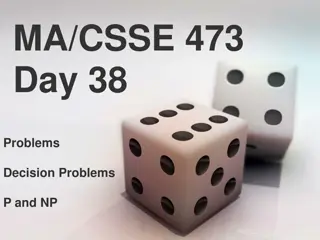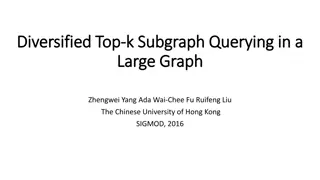Revolutionizing Education with an Interactive Learning Platform - CLIQUE
CLIQUE is a game-changing interactive learning platform designed to address the shortcomings in traditional education systems by empowering educators and students with advanced tools and technologies. Through features like self-learning, streamlined content delivery, e-content creation, and live cla
9 views • 11 slides
Distributed Computation in Node-Capacitated Networks
Exploration of communication primitives and algorithms in node-capacitated networks, including Node-Capacitated Clique Model, communication on butterfly networks, orientation using Boruvka's algorithm, computing O(a)-orientation, and solving graph problems like BFS trees, maximal independent set, ma
6 views • 7 slides
Graph Theory Concepts: Clique and Independent Set in C++ Programming
Explore the concepts of cliques and independent sets in graph theory through C++ programming with Cynthia Bailey Lee's Creative Commons licensed materials. Understand NP-complete graph problems and learn about coding implementations for determining cliques and independent sets efficiently.
3 views • 24 slides
Efficient Interactive Proof Systems Overview
This document discusses various aspects of efficient interactive proof systems, including doubly efficient IPs, simple doubly efficient IPs, and the Sum-Check Protocol. It explains concepts such as completeness, soundness, and strategies for verifiers and provers. The content covers examples like NP
5 views • 12 slides
Density-Based Clustering Methods Overview
Density-based clustering methods focus on clustering based on density criteria to discover clusters of arbitrary shape while handling noise efficiently. Major features include the ability to work with one scan, require density estimation parameters, and handle clusters of any shape. Notable studies
3 views • 35 slides
P, NP, NP-Hard, NP-Complete Problems and Amortized Analysis
This comprehensive study covers P, NP, NP-Hard, NP-Complete Problems, and Amortized Analysis, including examples and concepts like Reduction, Vertex Cover, Max-Clique, 3-SAT, and Hamiltonian Cycle. It delves into Polynomial versus Non-Polynomial problems, outlining the difficulties and unsolvability
6 views • 32 slides
Reform Movements in Upper and Lower Canada
William Lyon Mackenzie led the Reformers in Upper Canada against the Family Compact while Louis-Joseph Papineau led the Patriots in Lower Canada against the Chateau Clique. Both movements aimed for a democratic style of government, constitutional reforms, and more power to the legislative assembly.
4 views • 6 slides
Decision Problems in P and NP Complexity Classes
Decision problems play a crucial role in the realm of computational complexity theory, defining questions with binary answers that form the basis of the P and NP classes. This article delves into the significance of polynomial-time algorithms, distinguishes between tractable and intractable problems
2 views • 32 slides
NP-Completeness: Cook-Levin Theorem and Clique Problem
Today's lecture delved into NP-completeness, focusing on the Cook-Levin Theorem and the Clique Problem. NP-completeness is defined as a language that is in NP and all other languages in NP are polynomial-time reducible to it. The Cook-Levin Theorem states that SAT, a Boolean satisfiability problem,
1 views • 10 slides
Distributed Symmetry-Breaking Algorithms for Congested Cliques
This study delves into distributed algorithms for congested cliques, exploring concepts like the local model, congested clique model, routing schemes, and Main idea of Arboricity in graphs. It presents previous results and our findings, emphasizing the efficient handling of communication networks re
3 views • 32 slides
VLSI Channel Routing
Explore VLSI channel routing challenges, types of VLSI channels, and constraints involved. Learn about graph problems like Minimum Clique Cover and their application in VLSI channel routing.
4 views • 22 slides
Design and Analysis of Algorithms: Tutorial 10 Overview
In this tutorial, Chengyu Lin covers Decision, Search, Optimization, Class P & Class NP Reductions, NP-Completeness, various problem forms, and the three forms of CLIQUE. It delves into Language and Decision Problems, class P versus class NP, deterministic and nondeterministic polynomial time, and t
2 views • 20 slides
Distributed Algorithms on Congested Clique and Local Models
Explore the concepts of distributed algorithms on a congested clique and the LOCAL model. Discover the practical relevance and applications of these models in overlay networks and small cliques within larger networks. Delve into lower bound graphs and the history of MST Lower Bound.
2 views • 41 slides
Diversified Top-k Subgraph Querying in Large Graphs - Problem Definition and Solutions
Explore the problem of top-k subgraph querying in large graphs, aiming to provide diversified results with reduced overlap. Learn about the challenges, naive solutions, and proposed algorithms, including Ullmann framework and diversified top-k maximal clique approach.
3 views • 19 slides
Computational Complexity and Reductions in Computer Science
Explore the concepts of computational complexity, polynomial time reductions, and problem classifications in computer science. Learn about NP-Completeness, relative complexity of problems, and examples like Independent Set vs. Clique and Vertex Cover. Gain insights into the comparison of problems ba
0 views • 21 slides
Analysis of Approximation Algorithms for Combinatorial Problems
In this study, heuristic algorithms for approximate solutions to polynomial complete optimization problems are examined, evaluating their worst-case behavior and performance compared to optimal solutions. Various combinatorial problems such as the knapsack problem, set covering problems, and finding
4 views • 32 slides
Detection of Association-Based Clique Outliers in Heterogeneous Networks
Learn about association-based clique outliers in heterogeneous information networks and how they are detected using a conjunctive select query. Discover the applications and examples of ABC outliers, as well as the concept definitions and algorithms used in this detection process.
0 views • 20 slides
Clique Percolation Method (CPM) in Network Analysis
Explore the Clique Percolation Method (CPM) developed by Eugene Lim for detecting overlapping communities in networks. Learn about cliques, k-cliques, and adjacent k-cliques in the context of CPM, enabling a deeper understanding of community structures within a network.
6 views • 55 slides
Introduction to Complexity Theory and NP Problems
Explore Complexity Theory topics such as the complexity of the clique problem, NP complexity class, and examples like FACTOR in NP. Understand the concept of NP as a tool for computational reasoning and the verification of certificates in a nondeterministic context.
0 views • 30 slides
Speeding Up Set Intersections in Graph Algorithms with SIMD Instructions
Learn how to optimize set intersections in graph algorithms by leveraging SIMD instructions, QFilter, BSR, and GRO techniques for faster comparisons and improved efficiency in processing large graphs. Enhance performance in tasks like triangle counting, maximal clique detection, and subgraph matchin
5 views • 13 slides
Understanding Complexity Theory: NP, P vs. NP, PSPACE, and EXP
Explore the concepts of NP, P vs. NP problem, verification of certificates, and the complexity of problems in NP using brute-force search. Dive into the relationships between complexity classes P, NP, PSPACE, and EXP, and the implications of their containment. Discover the significance of CLIQUE in
0 views • 21 slides
Enumeration Framework for Clique and Subgraph Analysis
Explore the output-sensitive enumeration framework for analyzing cliques, maximal cliques, and dense subgraphs. Utilizing reverse search algorithms and family tree realization techniques to efficiently identify solutions. Discover the complexities and alternative output strategies for optimal comput
3 views • 54 slides
If you are looking for Billiard Game in Benoi Sector
If you are looking for Billiard Game in Benoi Sector, Clique Billiards (Pool Hall) in Jurong West is the ultimate destination for cue sports enthusiasts, offering a vibrant and welcoming pool and snooker hall where players of all levels can enjoy top
0 views • 6 slides
Best Video Game Cafe in Rochor
If you\u2019re looking for a Video Game Cafe in Rochor, then contact Clique Gaming Cyber Cafe LAN Shop & VR centre (Video games) (Console games) (Darts)\u7f51\u5427. Visit-\/\/maps.app.goo.gl\/LeWc2ADpNw1CAyzi10
0 views • 6 slides
Understanding Approximation Algorithms and Ratios
Dive into the world of approximation algorithms and ratios, exploring concepts such as approximation ratios for minimization and maximization problems, the importance of approximation in finding the minimum vertex cover and maximum clique, and different techniques used in approximation algorithms. E
3 views • 32 slides
Complexity Theory Explained: Cook-Levin Theorem and NP-Completeness
Unravel the intricate concepts of complexity theory as we delve into the Cook-Levin Theorem, NP-completeness, 3-SAT problems, and the NP-hardness of CLIQUE. Understand how chaining reductions from 3-SAT to CLIQUE provide insights into proving NP-completeness. Follow a detailed proof that connects 3-
3 views • 25 slides

























